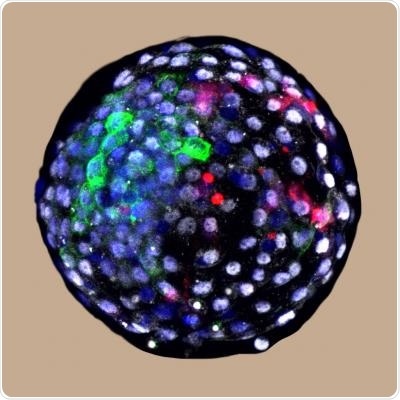Scientists from China and the United States have been able to grow chimeric embryos for a considerable period of time— up to 20 days—by injecting human stem cells into primate embryos.

This image shows a chimera human-monkey blastocyst. Image Credit: Weizhi Ji, Kunming University of Science and Technology.
Although the study raises ethical concerns, it has the ability to offer a new understanding of evolution and developmental biology. It could also help develop new models of human biology and disease. The study was published in the journal Cell on April 15th, 2021.
As we are unable to conduct certain types of experiments in humans, it is essential that we have better models to more accurately study and understand human biology and disease. An important goal of experimental biology is the development of model systems that allow for the study of human diseases under in vivo conditions.”
Juan Carlos Izpisua Belmonte, Study Senior Author and Professor, Gene Expression Laboratory, Salk Institute for Biological Sciences
From the 1970s, researchers have made interspecies chimeras in mammals. They were produced in rodents and employed for the analysis of early developmental processes.
The scientific progress that rendered this study viable was achieved last year when the collaborating group of this study—headed by Weizhi Ji of Kunming University of Science and Technology in Yunnan, China—developed a technology that enabled monkey embryos to survive and grow outside the body for a longer period of time.
In this study, six days following the creation of the monkey embryos, 25 human cells were injected into each one. The cells were derived from an induced pluripotent cell line called extended pluripotent stem cells. These pluripotent stem cells can promote both embryonic and extra-embryonic tissues.
One day after the injection, human cells were identified in 132 embryos. Ten days later, 103 of the chimeric embryos were still forming. Very soon, survival started to decline, and after 19 days, only three chimeras survived. However, a significant fact is that the percentage of human cells in the embryos stayed high throughout the entire time they continued to grow.
“Historically, the generation of human-animal chimeras has suffered from low efficiency and integration of human cells into the host species,” noted Izpisua Belmonte.
Generation of a chimera between human and non-human primate, a species more closely related to humans along the evolutionary timeline than all previously used species, will allow us to gain better insight into whether there are evolutionarily imposed barriers to chimera generation and if there are any means by which we can overcome them.”
Juan Carlos Izpisua Belmonte, Study Senior Author and Professor, Gene Expression Laboratory, Salk Institute for Biological Sciences
The researchers carried out transcriptome analysis on both the monkey and human cells from the embryos.
From these analyses, several communication pathways that were either novel or strengthened in the chimeric cells were identified. Understanding which pathways are involved in chimeric cell communication will allow us to possibly enhance this communication and increase the efficiency of chimerism in a host species that’s more evolutionarily distant to humans.”
Juan Carlos Izpisua Belmonte, Study Senior Author and Professor, Gene Expression Laboratory, Salk Institute for Biological Sciences
A crucial next stage in this study is to perform an in-depth evaluation of all the molecular pathways involved in this interspecies communication, with the immediate aim of identifying the pathways that are crucial to the developmental process.
In the long term, the team intends to use the chimeras not just to analyze early human development and model disease but also to create new techniques for drug screening, while possibly producing transplantable cells, tissues, or organs.
An associated Preview in Cell details the prospective ethical considerations involved with the production of human/non-human primate chimeras.
Izpisua Belmonte added that “it is our responsibility as scientists to conduct our research thoughtfully, following all the ethical, legal, and social guidelines in place.” He noted that before starting this study, “ethical consultations and reviews were performed both at the institutional level and via outreach to non-affiliated bioethicists. This thorough and detailed process helped guide our experiments.”
Source:
Journal reference:
Tan, T., et al. (2021) Chimeric contribution of human extended pluripotent stem cells to monkey embryos ex vivo. Cell. doi.org/10.1016/j.cell.2021.03.020.